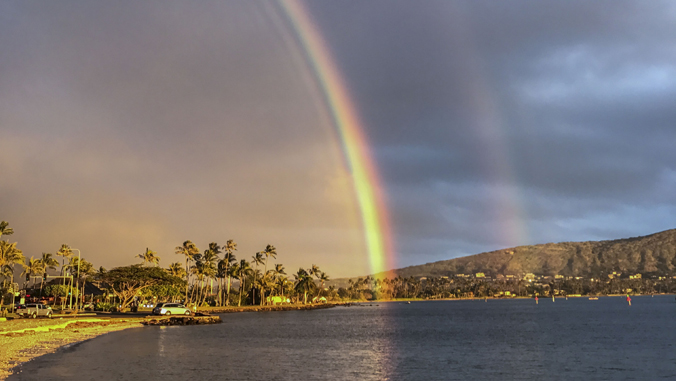
Rainbows are some of the most spectacular optical phenomena on Earth, and Hawaiʻi has an abundance of them. In honor of National Find a Rainbow Day on April 3, UH News chatted with rainbow expert Steve Businger, a professor in the Department of Atmospheric Sciences at the University of Hawaiʻi at Mānoa School of Ocean and Earth Science and Technology, to hear why he has dubbed Hawaiʻi the “Rainbow Capital of the World.”
Related: Secrets of the best rainbows on Earth, March 2021
Businger’s area of expertise involves the evolution of storms and hazards associated with them. He studies everything from severe thunderstorms to hurricanes and winter storms.
Businger also works with students on forecasting skills and with scientists on improving numerical weather prediction modeling.
Why did you start studying rainbows?

Rainbows are such a spectacular phenomenon, and they’re very common in Hawaiʻi. In fact, compared to other places I have dubbed Hawaiʻi the rainbow capital of the world, because they are so common here, thus it’s natural to be curious about how they form, why they form, and what they tell us about the atmosphere.
Why does Hawaiʻi have so many rainbows?

Hawaiʻi has a lot of sunshine, but we also have trade wind showers and the mountains help to enhance those trade wind showers. Our weather is characterized by small showers and lots of blue sky that allows the Sun to get in to illuminate the raindrops. Another aspect that makes Hawaiʻi perfect for rainbows is that we have very clean air. We have bright sunshine, but the clean air also means you have fewer condensation nuclei, leading to fewer, larger cloud drops in a cloud. And that allows coalescence where the droplets collect together to form raindrops to occur more easily. So we get rain out of very small clouds, and sometimes you’ll have a rainbow and you look up and it’s blue sky. All of these conditions make it so that Hawaiʻi is perfect for rainbows.
How do rainbows appear?

When the light comes into a raindrop, it gets bent because the light travels slower through liquid drop than it does through the air and then it reflects off the back of the drop and then it bends again at the front of the drop and the angle that results is about 42 degrees above the head of your shadow when you face away from the Sun. When the Sun is lower than 42 degrees above the horizon, you have the chance of seeing rainbows. But if the sun is too high, then you have to be in a helicopter or you have to have a lawn sprinkler to be able to see a rainbow. There is a free app available for your smartphone that can help you find rainbows called RainbowChase. The app knows where the sun and rain are and shows you where to go on a map of Hawaiʻi when rainbows are possible.
What kind of impact will climate change have on rainbows?
Global warming is impacting the distribution of rainfall across the Earth. The areas in the subtropics are becoming drier and areas where you have convective rainfall, thunderstorms, and snow are all extending further north to higher latitudes. As a consequence, the rainbow pattern is changing. The subtropics will see a bit less rainfall and a bit less rainbows, and further north with less snow, more rain and more convective showers, we’ll see more rainbows.


